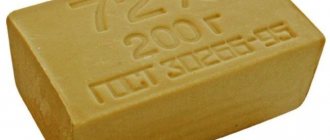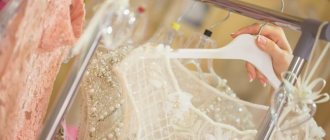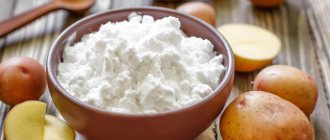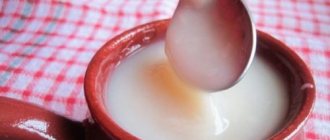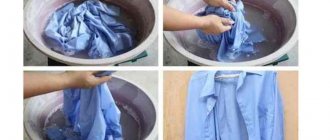To give the perfect silhouette and aesthetic appearance to skirts, starch has long been used. For women in the modern world, this process is completely unfamiliar, even somewhat frightening. However, do not forget that starching things effectively protects the fabric from damage, dirt, water, gives it whiteness, and thanks to starch, things will not wrinkle.
How to give something elegance and at the same time protect it from moisture and from losing its full shape at home, using only starch?
For what purpose are things treated with starch?
Half a century ago, housewives tried to starch almost all the things in the house made from natural fabrics. Most of all, table linen, bed linen, napkins, collars, cuffs, men's shirts, panama hats and curtains suffered the most. This was done for several reasons at once, because starched things:
- retain their attractiveness and purity longer;
- wrinkle less;
- last longer;
- gain additional strength;
- bleach over time.
Now, individual wardrobe items, skirts, hats, and furniture covers are subjected to this procedure. A starched item is able to retain its shape, which is extremely necessary for individual products. Also, there may be a “production necessity” in carrying out the starching procedure. A striking example of this is the tutu of ballerinas, who keep their shape despite complex pirouettes and steps.
Dermatologists do not recommend starching bed linen, as this reduces the breathability of the fabric. This may lead to skin irritation.
Basic details of the procedure
Understanding all the main points in how to starch a dress for pomp will allow you to achieve a good result
It is very important to know what is needed to process the product itself and how to then properly dry and iron the processed material.
Types of starch solution
During the treatment process, solutions of completely different concentrations can be used. It all depends on the type of fabric and the desired result. There are several ways to treat things with starch solution:
- Soft. Mainly used for thin fabrics that require careful handling (chiffon, tulle, knitted items), where special rigidity is not needed. The solution is prepared by mixing one liter of water with one teaspoon of starch.
- Average. Suitable for products made from cotton and linen fabrics (bed linen, shirts). This is the method used to process wedding dresses and petticoats. The solution consists of one liter of water and one tablespoon of starch. Read about washing a wedding dress here.
- Hard. It is used to process individual parts of clothing (cuffs, lace, collar, frill). In a multi-layered outfit, the petticoat is treated using this method. The solution is prepared from one liter of water and two tablespoons of starch.
In the modern world, there are other opportunities to starch a dress at home.
In the same household chemicals department you can purchase liquid and powder products for treating clothes. They must be added to the washing machine, and the item will turn out as starchy as after the solution.
Although there is a wide choice of chemicals, not all substances are gentle on fabric. The simplest and safest solution is considered to be a solution made from starch, and it is also an environmentally friendly and natural product.
Preparation for the process
Before you start starching your dress, you first need to prepare it. First of all, you need to clean your clothes:
- Check the surface of the fabric for stains. If they are found, then they should be removed in a manner appropriate to the tissue being treated.
- Be sure to wash and dry the dress at room temperature. You should not wait for the clothes to dry completely; the item should remain slightly damp.
Next, prepare all the accessories and ingredients for the starch mixture. You need to take:
- The container in which the mixture will be prepared. During operation, the solution may need to be heated, so it is better to use enamel dishes.
- Potato starch.
- A little water at room temperature and boiling water.
- Tool for stirring the solution.
Starch is placed in the prepared container and, with constant stirring, it is filled with water at room temperature until a mushy state is obtained. Then add boiling water little by little
It is very important here to prevent the formation of lumps, but if this could not be avoided, then the lumps must be removed from the solution
Which fabrics can and cannot be starched?
Products made from natural fabrics - cotton, silk and linen - can be treated with a starch solution. It is absolutely not necessary to carry out the procedure every time after washing. Dark things do not starch, because there is a possibility of unsightly stains.
Also, for hygienic reasons, it is prohibited to starch underwear. As for fabrics containing synthetic fibers: they cannot be starched in the traditional way. Because the expected effect may not be achieved. But it’s worth trying alternative methods that are used for products made from guipure, chiffon, and organza.
Carrying out the procedure
The whole procedure begins with determining the type of fabric; the stages of starching will depend on this.
Tulle skirt
How to starch a tulle skirt? Before you start the procedure, find out how much the lower layers of the skirts can be processed. Make sure that the solution does not get on the front side of the product.
You can starch a tulle skirt by following the instructions:
- Lay the item out on the oilcloth. Straighten out all the details.
- Using a sponge, gradually apply the composition. First process the lower layers of the product. Gradually move towards the top. Before moving on to the next layer of the petticoat, give the treated part time to dry.
- Carefully straighten the layers and leave the item to dry on the oilcloth. The temperature should be room temperature.
- Using a warm iron, smooth the fabric. To make it more obedient, lightly moisten it.
Remember, the volume of a tulle skirt is always maintained by starching.
Mesh skirt
A children's mesh skirt is not as difficult to starch as it seems at first glance. But you need to be patient and careful.
To starch the product, follow the instructions:
- Dip the item into the prepared solution and leave for 5-7 minutes.
- Carefully remove the skirt and wring it out. It is better not to twist the product, otherwise kinks will appear and the shape will deteriorate.
- Dry the starched skirt with a warm iron. Do not forget that a mesh skirt requires delicate ironing.
After the procedure, hang the item on hangers and dry it.
Fluffy dresses
The starching procedure is required not only for full skirts, but also for festive and wedding dresses.
Starching a dress at home is not difficult:
- Prepare the starch mixture and cool it to room temperature.
- Place the item completely into the solution and leave for 5-10 minutes. Make sure that the liquid evenly covers the dress.
- Remove the product and squeeze it lightly. Do not apply force, otherwise unsightly kinks will appear.
- Place the dress on a hanger and dry.
If you starched a skirt or dress the first time and didn’t succeed, try again. Follow all recommendations strictly. There is no need to starch a product made of cotton, synthetics and silk. These materials do not maintain their shape.
The process of starching things is not as complicated as it seems at first glance. But before the procedure, you should familiarize yourself with the rules and try to prepare a starch solution.
Features of starching skirts made of different types of fabrics
Fatin . The fabric itself is quite rigid. Most often, the lower layers of a tulle skirt are starched. It is advisable to provide protection to the front side from the effects of paste. It is better to carry out the procedure on oilcloth, applying the working solution using a sponge.
The bottom layer is processed first, and then all the others (with the exception of the top one, the front layer). To prevent the layers from sticking together, you need to let each of them dry. The drying process should take place at room temperature. The final stage is ironing each layer with a moderately hot iron.
Net . The structure of the mesh resembles tulle. Consequently, starching of mesh skirts is carried out according to the above scheme. But there are nuances: a mesh skirt can be completely immersed in the solution. The average exposure time is 5 minutes. After this, the item should be removed from the solution and hung on hangers to drain and dry. It is recommended to iron all layers until they are completely dry.
Cotton . Natural fabrics with a high cotton content have a peculiarity: they absorb too much solution, which negatively affects the condition of the fabric. That is why it is recommended not to immerse the skirt completely in the paste, but to treat it with a starch solution from a spray bottle. In extreme cases, the mixture can be applied with a sponge. Treatment is carried out 2-3 times (after each layer has dried).
Linen . When starching linen items, there is a high probability of creases and folds appearing, which is explained by the characteristics of the linen. That is why during the processing process you need to strictly ensure that the product does not wrinkle. The skirt can be completely immersed in the starch solution, and the exposure time increases to 10 minutes. After incomplete drying, the item should be carefully ironed.
Atlas . If the fabric is dense, then to starch the skirt you need to use a more concentrated solution. The exposure time is the maximum possible (15 minutes). After processing, the item can be slightly wrung out. Ironing is carried out after complete drying.
It is noteworthy that it is not recommended to treat satin and natural silk with a starch solution, as this causes them to lose their shine. One of the alternative options should be considered. For example, using gelatin.
How to dry and iron
As the fabric dries, starch crystals remain in the fabric fibers, and the product becomes tougher than before the procedure. To prevent the dress from acquiring a bizarre shape, you should follow six rules for drying and ironing.
- Spin. It is allowed to squeeze the product a little to remove excess moisture. Do not twist the fabric or squeeze it dry.
- Drying position. The dress or skirt is dried on a hanger or hanger with clips. Ideally dry on a mannequin. The product must be straightened, giving the hem a fluffy shape. If a woolen dress is being dried, it must be placed horizontally.
- Drying lace. To prevent lace, fringe, ribbons and other elements from sticking or crumpling, they should be straightened and secured if necessary. The lace can be pinned with needles to a flat surface, and the fringe can be combed with a sparse comb.
- Drying without a hair dryer or batteries. Do not try to dry the product quickly using heating devices and a hair dryer. It is best if the dress dries naturally at neutral room temperature. Hanging in the cold, and especially in the frost, is also not recommended.
- Damp cloth. It is necessary to start ironing when the starched dress is still damp. If the product has already dried, you should moisten it with a spray bottle and begin ironing. You can also place a damp thin cloth on top for ironing.
- Ironing temperature. Do not iron at high temperatures using steam. Depending on the thickness of the fabric, the average or minimum temperature is set.
Professional sprays (Chirton, Luxus “Superform”, Reinex) that are used on dry fabric will help make ironing easier and perform soft starching. It is enough to spray the product on the area and iron it through gauze. Spray treatment is great for soft and delicate fabrics.
Starching petticoats and tutu skirts
The topmost layer of such products does not starch. But if it is not the front one, then you can completely immerse the product in a highly concentrated solution. Leave to soak completely for 10 minutes. After draining (without spinning) and natural drying, the product should be ironed, setting it to the minimum temperature setting.
Is it possible to do without starch?
A solution with starch is not suitable in all cases; for example, for synthetic fabrics it would be more effective to replace it. Possible options:
sugar. Diluted with water 1:2
It is important to dissolve the sugar in the water before it boils, otherwise it may burn and give things a reddish tint; gelatin. Per liter of water from 2 to 4 spoons (depending on the desired hardness of the fabric)
Gelatin swells in water, after which you need to heat the water until it is completely dissolved. Thanks to this method, fabrics become more shiny; PVA. The most common glue can help give products a rigid shape. Proportions - 1 part glue to 2 parts water; ready-made mixtures, boron powder. Most often they are sold in stores in the form of sprays and are quite convenient to use; some of them can be added to the washing machine.
Preparing the mixture
How to prepare a skirt for starching
Before treating a garment with starch solution, the item must be washed. It must be perfectly clean even if an alternative method is planned.
Washing is carried out in accordance with the manufacturer's recommendations. All information regarding washing rules is presented on the label. Tulle skirts are washed by hand, taking all precautions.
If washing is carried out manually, it is not recommended to use washing powder. Poorly dissolved granules may remain on the fabric. For washing, it is better to use liquid or gel products.
If the skirt has decorative elements in the form of laces, belts, brooches, or false lace, then it is recommended to “dismantle” them before washing. Dried products are subjected to starching, but if they are slightly damp, this is not a reason to refuse the procedure.
Preparing to wear
The dried item must be ironed properly. It is recommended to tidy up a tulle skirt using a steamer or an iron with the appropriate function.
Remember that starched clothes wrinkle a lot.
If you have found a suitable remedy, read the instructions carefully and do as written. The concentration of the solution and the formulation are traditionally indicated on the packaging, so all that remains is to follow the advice exactly. Prepare your skirt. Remove all stains and dust from it. Wash or clean if necessary. The fact is that starch paste amazingly glues particles of a wide variety of substances, including dust particles, to fabric.
To prepare your own solution, add 1 tablespoon of starch to 1 glass of water and mix thoroughly. There shouldn't be any clots. Boil another 0.5 liters of water. Pour the starch solution into it, mix thoroughly and leave on the fire for about half a minute. You should get something like a transparent gray jelly. If you mixed everything well, then the mass will be homogeneous, and nothing else needs to be done with it. If there are lumps, strain the paste through cheesecloth or a fine sieve.
Pour cool water into a bowl.
Its size should be such that the skirt, folded several times, fits freely there and does not float to the surface. Pour the paste into the water and place the skirt there. Move it from side to side in much the same way as you do when rinsing. The time depends on the desired hardness. Traditionally, soft starch is used, so a couple of minutes will be enough. Take out the product and squeeze it out. The best way to do this is to wrap the skirt in an unnecessary piece of gauze. But you can also squeeze it out with your hands. You should not twist such a product, otherwise it will be quite difficult to give the skirt a suitable shape later.
Spread a large piece of unmarked fabric on a flat surface. For this purpose, for example, an ancient sheet is suitable. You can also use a flat, huge board, if only the skirt fits one hundred percent on it. Lay the skirt on it, straighten out all the folds. Let it dry completely. Don’t be afraid that the skirt will dry out, don’t rush, but don’t put off finishing the work for several days. Carefully iron the product. At the same time, set the iron regulator to the mark appropriate for the fabric.
Proportions
The use of starch allows you to regulate the “degree of hardness” of the processed product. However, the type of fabric also matters. The table provides information that will help you determine the dosage of starch (per liter of water).
| Rigidity | Name of fabric or product | Starch, tsp. |
| Minor | Tulle, chiffon, silk | 0,5-1,5 |
| Soft | Gauze, cambric, cotton tulle | 1,5-2 |
| Average | Linen, cotton | 2-3 |
| High | Decorative jewelry, tutus, gauze petticoats | 3-6 |
Starching of some products
How to starch curtains:
- Calculate the amount of starch in the proportion of 1 or 1.5 teaspoons per liter of water. It depends on the density of the product (tulle or thick curtain).
- Dilute the granular substance in cold water, then add warm water and heat. When you get a transparent sticky mass, pour in cold water and stir quickly.
- Place the product there for half an hour. Wring it out well, dry it a little and iron the wet item.
How to starch shirts at home:
- For thin chiffon, cambric or silk shirts, a soft solution is used.
- Linen or cotton shirts are treated with a medium-hard compound.
- Cuffs and collars need hard starching.
- The shirt is soaked in the solution for a quarter of an hour and gently wrung out. Dry on hangers over the bath so that the water drains.
- Iron a slightly damp item. They do this quickly, removing creases and folds. If you dry it with an iron, yellow traces of starch will remain. The shirt should dry completely after ironing.
Read about: cleaning suede at home: effective methods.
Particularly hard solution
By adding borax you can get a composition for very hard starch:
- pour 3 tablespoons of starch into a saucepan with a liter of cold water;
- pour a teaspoon of borax into a glass of boiling water, stir and cool;
- add one mixture to the other and leave for an hour, then stir;
- Soak cuffs, collar or other hard item in the solution and dry.
This method will take from 5 to 15 minutes
It is important that the solution completely saturates the material
Rules for preparing starch solution
Classic fabric processing involves the use of potato starch. Because, compared to rice and corn starch, it thickens faster, has a snow-white tint and produces a more viscous solution, which is not unimportant. The utmost attention is paid to the quality of raw materials, because second-grade starch leaves white streaks after drying. The suspension used for the procedure is called “starch milk”.
The success of the event depends largely on how correctly the composition was prepared. In order for starch milk to have a uniform structure, you need to take the required amount of powder and dissolve it in a glass of warm water.
At the same time, you need to boil the required amount of water and pour the resulting solution into it in a thin stream, stirring constantly. Ready starch milk has the consistency of a paste.
If the appearance of lumps cannot be avoided, then you should strain the solution through a sieve or filter consisting of several layers of gauze.
Starching
The starch solution is made from the substance of the same name.
In principle, there is no big difference in what kind of starch you will use; you can take potato, rice, corn, and you will not have to adjust the proportions of the recipe. Our fellow citizens prefer potato starch. Starching is divided into several types according to hardness, so it is better for you to decide before starting work what result you want to achieve. Depending on your wishes, the composition of the starch solution will be different:
- If you only need to lightly secure the fabric, then 1 teaspoon of consistency per 1 liter of water is completely enough.
- For the most powerful composition, make a solution from 1 tablespoon of starch per 1 liter of water.
- The most powerful composition involves using 2 tablespoons of starch per 1 liter of water, and also adding 1 teaspoon of borax to the consistency.
For skirts and dress petticoats, the average composition is traditionally used, which is extremely simple to do:
- In the first step, we need to boil a kettle of water and pour half a liter of boiling water into a container.
- Then dilute 1 tablespoon of starch in another half-liter jar with cool water.
You need to carefully stir the solution so that there are no lumps. - Now we combine boiling water with the starch substance, and put the resulting consistency on the fire. Boil the mixture for about 5-10 minutes, stirring frequently, until the solution becomes virtually clear.
- Let the mixture cool, and then strain it through cheesecloth or a sieve to completely remove any lumps.
After cooling, you will have a starch composition that will vaguely resemble jelly. Mix this jelly in a bowl with cold water.
If we want to refresh and starch a snow-white skirt, we can add a little bluing.
It's time to load our dresses and skirts into the composition. The main task is not to wet the product, but to achieve the application of the starch composition to the entire surface of the fabric, so we simply bathe the clothes in water, moving them from side to side. When the starchy water has rinsed the entire fabric, it can be removed, gently squeezed without stretching or twisting, and sent to dry.
Children's tulle skirt
Depending on the desired shape, things can be dried either horizontally or vertically, on a hanger.
The most important thing is to achieve the desired shape and completely straighten the fabric. Under natural conditions in a ventilated room, clothes dry quite quickly.
After drying, tulle items can be steamed. It is comfortable to do this when the fabric is still a little wet. In this case, you can use both an iron and a steamer. Carry out the work carefully so as not to wrinkle the clothes; you can slightly refresh them with a spray bottle if they have dried out.
Step-by-step instruction
- Prepare starch milk. If necessary, you can increase the amount of powder and liquid, strictly maintaining the proportions.
- Completely immerse the item in the solution and wait 6 minutes.
- Before removing the product from the solution, you must carefully inspect it and make sure there are no dry areas.
- Remove the skirt from the starch milk, carefully straighten all the folds and allow excess liquid to drain.
- Leave the item to dry in a vertical position (for example, on a hanger).
- When the product is almost dry, it is recommended to iron it with a not very hot iron. At the same time, it is strictly forbidden to moisten or steam the fabric! A starched item only needs dry heat, because water destroys the thin “crust” formed on the surface.
Procedure for the starching process
With almost all types of fabrics, the starching process occurs as follows:
- We select a large container into which the entire skirt can easily fit, fill it with cold water and dilute the pre-prepared starch paste in it;
- We place the skirt in the solution so that its entire surface is immersed in the liquid and has the opportunity to be completely saturated with the mixture (for this it is recommended to rinse the item in the liquid);
- We take the skirt out of the solution, barely wring it out, and lay it out on a clean, large horizontal surface or hang it on a hanger;
- During the drying process, lightly give it the shape we want and let the skirt dry;
- After drying, go over the fabric with an iron.
Alternative methods at home
Sugar syrup. Pour 0.25 liters of water into a small saucepan, heat to about 40 degrees and add 100 g of sugar. Mix thoroughly, wait for the syrup to boil, but it should not turn yellow. For processing, sugar syrup cooled to room temperature is used.
Gelatin . Pour 1 tbsp. l. gelatin with a small amount of water (about 15 ml) and leave to swell. After half an hour, pour 100 ml of water into the swollen mixture and heat the solution, preventing it from boiling. This composition has at least 2 key advantages: it can safely process synthetic fiber fabrics; After drying, the gelatin does not crumble.
PVA glue . Dilute 100 ml of PVA glue in 300 ml of water. Dip the product into the resulting solution. It is worth noting that this composition gives the product “extreme rigidity”.
Hair fixation spray . Treat the product with super-strong hold hairspray. This method is used for skirts made from soft tulle, when there is no time to use the “classic starch” pattern.
How to starch correctly
In order to starch clothes, table linen or bed linen, potato starch is most often used. You can also find other types of starch on sale, for example, rice, corn or wheat, but powder made from potatoes is better suited for this procedure than others.
Potato powder is best
In appearance, potato starch is a snow-white powder with very small particles, which is dissolved in water, observing certain proportions.
You can starch a wet, slightly damp, or even completely dry fabric, as long as it is completely saturated with the solution. Depending on how dense and rigid the material needs to be made, the method of starching is chosen.
Weak solution
You can starch in the washing machine.
A weak solution is used to stiffen bedding, snow-white blouses and blouses, and light summer dresses. If you overdo it with starch when processing everyday clothes, the clothes will become uncomfortable to use.
The method for preparing a weak solution is as follows:
- take starch powder at the rate of 1 tsp. for 1 liter of water;
- pour the entire portion of starch into a small container (glass, half-liter jar) and add a little cold water;
- the powder is mixed with water until a homogeneous mass is obtained;
- pour the required amount of water into an enamel or aluminum pan and bring to a boil;
- dissolved starch is poured into boiling water in small portions; In this case, the solution must be constantly stirred to prevent the formation of clots and lumps.
The resulting mixture should be cooled to room temperature. The consistency of the solution should be slightly denser than water, slippery to the touch. Items intended for starching are immersed in the solution for a few minutes, then gently wrung out and hung to dry.
To process small parts, you can use a spray bottle. A weak starch solution is poured into the flask and sprayed onto the cuffs or collar. This method is convenient because you don’t have to wet the entire product.
Medium concentration solution
It is better to starch tablecloths and napkins, lace, bed linen, curtains and covers for upholstered furniture. To do this, use a solution of medium concentration, for the preparation of which take 2 tsp. starch per 1 liter of water. Otherwise, the method for obtaining the mixture is completely identical to that described above.
Hard starch solution
When making stage costumes or decorative elements, sometimes it is necessary to starch the material so much that it resembles cardboard in density. In these cases, hard starching is used, the solution for which is prepared as follows:
- sodium boric salt (borax), taken in an amount of 1 tsp, is diluted in 200 ml of hot water and cooled to 25 ° C;
- dilute 2 tbsp in a glass of cold water. l. starch;
- boil 1 liter of water and pour starch solution and diluted borax into it;
- All components are thoroughly mixed and left to infuse for 2 hours.
After treatment with this solution, the fabric does not bend or break and holds its shape perfectly.
You can starch bulky items, such as bed linen, tablecloths or tulle, in the washing machine. To do this, pour the diluted starch into the conditioner compartment. After the rinse cycle ends, starching will occur automatically. All that remains is to take out the clean things and hang them to dry, and wipe the drum of the machine with a damp cloth to remove starch.
Product for starching things
Starch Luxus Superforma, 400 ml
A product whose use allows you to starch and give shape to even dry laundry. Starch can be used on white or colored fabrics. After application, the drug does not form an airtight film. Purpose of application: maintaining the shape of the product and preventing the appearance of contamination on the surface.
Fabric starch Sano Iron Easy, 700 ml
A spray used to care for clothes and give them a more presentable appearance. This drug is best used during ironing. Before carrying out the procedure, you need to lightly spray the laundry with a solution containing silicone, fragrance and starch. After ironing, the fabric becomes smoother and the item acquires a pleasant aroma.
G&G Spruh Starke laundry starch, 500ml
The drug can be used on any fabric, with the exception of silk. The purpose of its use is to starch laundry, which is done when ironing it. The product is ideal for ironing dry laundry. In this case, you can refuse additional options that are available in any modern iron. To iron your laundry, you must first spray it with an aerosol.
Preparatory activities
The starch solution is applied only to pre-washed items . Clean items can become dusty even after being stored for a short time. Sometimes the products show various stains or yellowing. In order to get rid of them, the skirt should be washed using special products. Grease stains are easily removed by dishwashing liquid previously applied to the fabric. Yellow areas can be removed with hydrogen peroxide.
First, let's carefully examine the product with which we will work. Its fabric must be absolutely clean. This is important because the starch solution, if it gets on dirt or dust, will change the white color and give it a yellow or gray tint. It will be possible to get rid of it only after the starch is completely removed.
Make sure that there are no streaks left on the surface of the fabric after rinsing the product . Residues of washing powder or gel can also change the color of the skirt.
Review
Marina, Moscow: “I know very well how to starch a skirt using starch paste. I'm sure other women can do this too. But “the trick with starch works” only if the fabric is light. I can give useful advice to anyone who needs to starch a skirt made of dark fabric. To prepare the solution, you need to take 30 g of gelatin, dissolve it in 0.5 liters of water and let it swell.
After about an hour, place the mixture in a water bath, and when the lumps disappear completely, pour in 2 liters of cold water. When the solution has cooled slightly, add 2 tbsp. l. glycerin. Place the washed and rinsed skirt in a gelatin-glycerin solution. Wait a couple of minutes, remove the product, and let it drain. Drying implies fulfilling the following requirements: ensuring the product is in a vertical position and optimal temperature and humidity conditions in the room.”
DIY starch spray for ironing
You can make your own starch spray. This requires:
- 400 ml warm water;
- 1 tablespoon starch;
- 2 drops of any essential oil (optional).
Mix starch in water and pour the solution into a spray bottle. If you wish, you can add a couple of drops of any essential oil whose smell you like to the solution. Before spraying the solution onto the fabric, shake the bottle vigorously several times.
Some more useful starch tips:
- You should not starch your underwear, because its task is to give the body softness, comfort, warmth, and absorb sweat, and impregnation with starch prevents this.
- To give starched linen a slight shine, add a little table salt to the solution.
- Corn starch leaves smudges and streaks on dark items; it is best used for colored items.
- After starching, it is better to dry crocheted and knitted items on a thick fabric backing in a slightly stretched form, securing the shape of the product with needles.
- When starching embroidered items, too strong a solution gets clogged between the colored threads and spoils the appearance of the embroidery. For embroidered products you need to use soft starch.
- Adding a few drops of turpentine to the starch mixture will prevent starch particles from sticking to the iron while ironing.
- Before ironing, dry, starched linen can be sprayed with water from a spray bottle or wrapped in a damp cloth for a couple of hours.
- After removing the item from the starch mixture, do not wring it hard, this will give it maximum rigidity.
- To preserve the brightness of the colors of colored fabric, treat it with a starch composition only on the wrong side using a spray bottle or a special aerosol.
To visually study all the stages and methods of starching, and to understand in detail how to starch your favorite dress, watch the video. This simple procedure will significantly improve the appearance of any sewing or knitted product. The time spent on the starching process will return to you with the joy of a perfectly well-groomed item - a dress, tablecloth, bed linen. Using such things, you touch real noble nobility and royal luxury.
How to starch individual elements
It happens that you do not need to starch the entire dress, but only a separate element - a collar, a belt.
In this case, the dress is washed, dried and ironed in the usual way. Then lay it out on a flat surface, apply the solution to the required parts using a spray bottle and let it dry. Try not to let the starch get on other parts of your clothing.
It is convenient to use a mannequin to process individual details of the dress.
Iron the processed parts while wet.
When preparing a wedding dress, you can combine several types of processing of the product:
- a solution of strong concentration is prepared for the lower layers;
- for average – weak;
- and the top ones are left naturally airy.
For children's dresses, bows and carnival costume details are starched. In this case, a strong solution is recommended, which will be sprayed through a sprayer.
What to consider when using starch
How to starch fabric is not a complicated procedure, but it does require some skills and knowledge. Recommendations for starching;
- the procedure must be repeated approximately every 4 washes, but not every time;
- if you squeeze starched fabric, you can get creases, so it’s better not to overdo it;
- for delicate items like lace, it is better to make a solution with rice starch and milk instead of water;
- Only freshly washed items are starched;
- a cloudy solution should not be used if you don’t want to throw it away - you can boil it for 5 minutes;
- the thick mixture can be diluted with water, the main thing is to preheat it;
Starching in a machine
- to obtain shine and smoother smoothing, add a quarter teaspoon of salt to the solution;
- Ironing clothes after the procedure should be slightly damp, and if they have already dried, walk with a damp cloth. To be safe, it is better to cover the starched fabric with gauze and iron it through it;
- things should dry naturally, away from radiators and direct sunlight;
- Sometimes a grayish powder is sold in stores; it cannot be used immediately. This starch is soaked in water, all unnecessary particles settle out, and then the solution is filtered and it is ready for use;
- If you don’t like the result after starching, you should just wash the item.
Available means for starching
Napkins and other interior items are starched.
If there is no starch in the house, and it is simply necessary to make the fabric more rigid, you can use such improvised means as sugar, gelatin or PVA glue. Of course, it is not advisable to resort to such means to treat clothes or bed linen, since it will be expensive. However, it is quite possible to starch a napkin or homemade flowers.
Sugar
In hot sugar syrup, prepared at the rate of 6 tbsp. l. sugar per 1 liter. water, lower the product requiring starching. As soon as the fabric is completely saturated with the sweet solution, the item is removed and laid out on a horizontal surface to dry.
Gelatin
Edible gelatin will help make the fabric denser and tougher. To prepare the mixture you need 1 tbsp. l. Soak gelatin in a glass of water for 1 hour. When the gelatin swells, place the container on low heat and, stirring constantly, achieve a uniform consistency. The product is immersed in the resulting solution.
PVA glue
You can simply and quickly starch product elements using PVA glue. To do this, the glue is diluted with water in a ratio of 1:2 and the resulting solution is coated with the fabric. You can starch not only white, but also colored things. However, white streaks may appear on black fabric after this treatment.
Currently, starching is not a particularly relevant process, but in some cases such processing cannot be avoided. Knowing simple techniques to make the fabric stiffer and denser, you can create unique decorative elements with your own hands and always keep your home clean.
How to return white underwear to its original appearance?
Stains are especially noticeable on white items, so simply washing them with detergent is not enough. It is necessary to use compounds that have a whitening effect. Read about what to do with a faded white item here.
Folk remedies
Laundry soap is effective in the fight against fresh stains. It contains fatty acids and caustic soda, which work well on stubborn stains. You can strengthen the recipe with citric or acetic acid.
Procedure:
- Grate natural laundry soap 72%.
- Dissolve it in warm water to form a paste of medium thickness.
- Add a little vinegar or citric acid to it.
- Apply the paste to faded areas.
- Leave for 4-5 hours.
- Wash the item as usual.
You can deal with the problem using dishwashing detergent. It contains surfactants that corrode paint molecules, making their connections less strong. Therefore, not a trace will remain of the stain.
Mode of application:
- mix dishwashing liquid and baking soda (2 tbsp and 1 tsp) in a separate container;
- apply the paste to the stain, leave to act for 3 hours;
- remove the composition with a soft brush;
- wash the item as usual.
Dishwashing detergent will remove the stain, and baking soda will bleach the fabric.
- lemon acid;
- salt;
- starch;
- crushed Aspirin tablet.
If the stain has already dried, hydrogen peroxide comes to the rescue. You can buy it at any pharmacy. It is not recommended to apply it in its pure form to things, so as not to spoil the fabric. Based on it, a solution is prepared at the rate of 50 ml per 5 liters of water.
Algorithm of actions:
- Pour the prepared solution into the basin. It should be warm, but not hot.
- Soak things in it for an hour.
- Rinse clothes and wash them as usual.
If the stains are not removed the first time, there is no need to wash the items. They are rinsed, a new solution is prepared and the procedure is repeated again.
Another effective remedy for removing stains from faded items is ammonia. A solution is prepared with it in which white fabrics are soaked:
- washing powder – 1 tbsp. l;
- ammonia - 1 tbsp. l;
- salt – 3 tbsp. l;
- warm water – 3 l.
The liquid is whipped until foam forms, after which the item is placed in it for 2 hours. After the specified time, the clothes are rinsed and washed as usual. The good thing about this recipe is that it can be used to wash delicate fabrics.
Household chemicals
When choosing a stain remover, you need to consider the type of fabric. If it is delicate, preference is given to the liquid form of the detergent. In other cases, you can use powder.
Professional stain removers that can be used for washing faded items:
- Vanish Oxi Action Gold. The oxygen bleach and stain remover included in the gel helps to quickly deal with even the most stubborn stains. Therefore, using it to wash faded items will not be difficult.
Fill a basin with water, add 1 measuring cap of detergent and soak the items for a while. For white fabrics, a maximum of 6 hours, after which the items are washed as usual. The cost of a 0.45 liter gel is 240 rubles.
Sarma Bleach Active. It does not contain chlorine and can be used for washing all types of fabrics. For 10 liters of water you will need 50 ml of detergent and the same amount of powder. Soak the item for 30-60 minutes, then wash as usual. The cost of the composition is about 80 rubles per package of 400 g of Bos Plus. This oxygen bleach enhances the action of laundry detergent, making it easy to remove even stubborn stains. For soaking, you need 40 g of bleach and the same amount of washing powder. Heavily faded items are kept in the solution for no more than 20 minutes, after which they begin normal washing. The higher the water temperature, the better the quality of the wash. The cost of a 600 g package is 160 rubles.
All of the products listed can be purchased in retail stores, in the household chemicals department, or ordered online.
The video will show you how to save a faded white item:
Why are garments starched?
A starched dress retains freshness and volume longer. For example, in ballet, all tutus are necessarily treated with the mixture before the performance so that they keep their shape and do not “fall” during various steps and ples.
At home, the use of starch is very wide. Previously, after washing, men's shirts, namely, collars and cuffs, were necessarily processed. Children's dresses also went through this procedure to give them pomp and wear. Even snow-white bed linen was dipped into the solution to maintain freshness.
Modern housewives and fashionistas starch things to solve the following problems:
- get a clearer and more voluminous shape;
- prolong the feeling of freshness and lightness;
- ensure that the fabric wrinkles less and does not require constant ironing;
- stiffen collars and cuffs.
